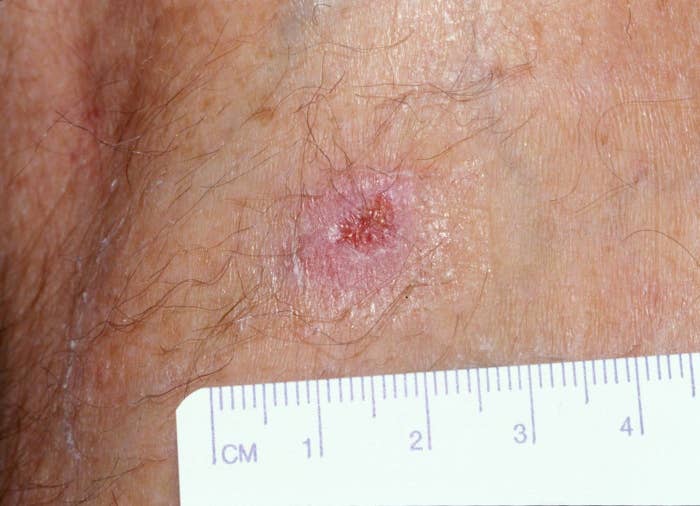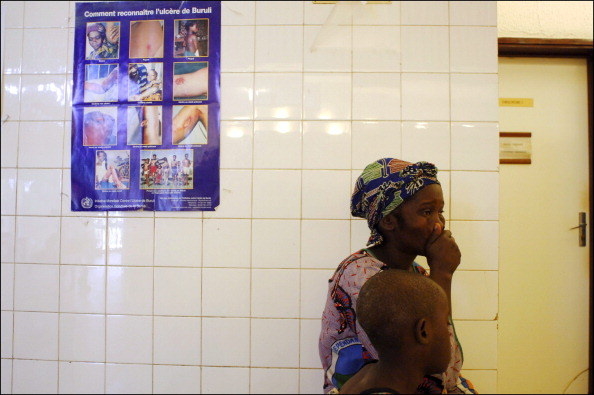Cases of Buruli ulcer were once considered rare in Australia, but now they're happening at epidemic levels.

The bump may initially look like a bug bite or pimple, but it is usually painless and it doesn't itch. The main characteristic is that it progresses very slowly and doesn't heal, Eiras said, most likely because it weakens the immune system or prevents it from functioning properly. The infection often affects the arms and the legs, but it still isn't clear why this happens.
Eventually, the bump will become an ulcer or an open sore, then progress if left untreated. "It will start to become larger, then it will invade the lower tissue and fatty layer under the skin and it may involve the muscle, tendons, and bone," Eiras said. It doesn't usually cause other symptoms such as fever or nausea.
Compared with other flesh-eating bacterial infections that spread quickly and kill tissue, such as necrotizing fasciitis, the Buruli ulcer is much less aggressive. "The bacteria do not really 'eat flesh,' they produce a toxin that dissolves the skin and tissue around it, but this could take weeks to months whereas an infection like staph can progress in a matter of days," Eiras said. It's rarely fatal.
That being said, severe cases of Buruli ulcer can cause permanent disfiguration and disability that significantly alter a person's life, Dr. David Blaney, medical officer with the bacterial special pathogens branch at the US Centers for Disease Control and Prevention (CDC), told BuzzFeed News.
Researchers still do not know how the flesh-eating disease is transmitted or where it comes from in the environment.

There is a lot of mystery surround this flesh-eating disease. The bacteria that cause Buruli ulcer are from the environment and usually associated with wetlands and stagnant water. However, it has been difficult to isolate the bacteria in the environment, Blaney said. So researchers are still trying to find its "natural reservoir" or source in Australia and other parts of the world.
"There’s speculation that it’s from stagnant water and there’s some correlation with certain rodents and opossums, and that mosquitoes play a role, but none of this has really been clarified," Eiras said. Without a clear understanding of where the disease is from and how it spreads, it's very challenging for health officials to come up with public health strategies to prevent Buruli ulcer epidemics.
"It's definitely a neglected tropical disease and tends to be endemic in poor, rural populations where it is not recognized generally by local health providers so the disease can advance, especially in parts of West Africa," Blaney said.
Buruli ulcers are not always easy to diagnose, but most cases can be treated with antibiotics and surgery. However, these can be costly.

Most cases can be treated with combinations of antibiotics such as rifampicin and clarithromycin, which have cure rates close to 100%, according to the article. "These are not typical antibiotics that someone might get if they go to their primary care doctor," Eiras said.
According to the article's authors, these medications are also not covered by the Pharmaceutical Benefits Scheme, a government program that provides subsidized medication to Australians.
Treatment may also require surgeries and other procedures such as skin grafts, Blaney said, which can vary depending on how much tissue has been destroyed. Between the medication, hospital visits, procedures, and lost productivity, it all adds up. The average cost of treatment for a Buruli ulcer infection is about $14,000, according to the article.
"The emotional and psychological impact on patients and their carers is substantial," the article's authors wrote. Therefore, early diagnosis and treatment is crucial. But this can be difficult because the symptoms progress so slowly. "People generally present fairly late with severe disease because the sore doesn't hurt and people just think it will go away," Blaney said.
Researchers are calling for increased funding to conduct research that will help stop the spread of Buruli ulcer — both in Australia and around the world.

"It's one of those diseases that really needs more research to determine how it’s transmitted and the actual numbers of people affected by it because we still don't know," Blaney said.
The authors of the study called on local, regional, and national governments to assist with funding to better examine the environment, local flora and fauna, human populations, and other factors related to the Buruli ulcer so researchers can better understand how to prevent it.
"It is only when we are armed with this critical knowledge that we can hope to halt the devastating impact of this disease through the design and implementation of effective public health interventions," the article authors wrote.

